
|
|
|
|
| Photo Gallery Location: Click HERE! |
- INDEX -
| Special Report | Loggerhead Sea Turtle | ||
| Many More Fish and Animals at Port of Nagoya Publick Aquarium!! | |||
SPECIAL REPORT
Here they come!
The Loggerhead Turtles were born in Nagoya.
What is Sea Turtle?The turtle living in the ocean. There are 7 kinds of turtles, Loggerhead turtle, Green turtle, Hawksbill turtle, Olive Ridley, Kemp’s Ridley turtle, Flatback turtle, and Leatherback turtle. All of them are critically endangered. In the north pacific, the Loggerhead turtles come to the beach in Okinawa, Kyushu Island, Shikoku Island, and Honshu Island up north to Fukushima prefecture to lay eggs. The Green turtles come to Bonin Islands, Yakushima, and Ryukyu Islands. The Hawksbill turtles come to Okinawa and southern islands. The Olive Ridley and the Leatherback turtle migrate to Japanese offshore. The biggest turtle among the seven is the Leatherback turtle up to 2 meters and 700 kg. The smallest is Kemp’s Ridley of 75cm and 45 kg. Most of sea turtle is omnivorous, feeds on jelly fish, shellfish, crustaceans such as crabs and shrimps, fish and so on. Green turtle feeds on sea vegetable. |
Port of Nagoya Aquarium is only the place where the breeding of loggerhead turtle is successful in Japan. The aquarium has led protection programs of the Loggerhead turtles. Artificial beach was prepared for the turtles for nesting in the aquarium. It took time for the sea turtle to start using the beach for nesting. Division Manager of turtle, Takashi Kasugai has watched the turtles since 1993 when the aquarium opened. "The turtles did not lay any eggs for the first 2 years. We made the beach very carefully, but forget about laying eggs, they even did not come up there", he said. His team changed the temperature of water and sand to get them to be in lay. After all the challenge, he found that it was better to leave them alone.
The team had kept watching the turtles to study. "The turtle was more delicate than what I had in mind. Turtles change their behaviour if there are people watching. So we kept distant to watch, then the turtle crawled up to the beach to lay eggs", said he. He also found a very important fact that the turtle often watched the condition and position of the beach before they come up from water. It is not easy and very challenging for human to create the good environment for turtle.
 Turtles come up to the beach from here. |
The turtles are now monitored by 2 cameras in water and 3 cameras on the beach. Their mating season is February, then the female turtles come up to beach from late April to June during night for nesting and lay eggs 4 or 5 times in one season. About 100 eggs are laid each time. The eggs are collected for artificial incubation in the Turtle Breeding Research Centre. The baby turtles are taken care after hatching, and the half of them are released to the open sea from off coast of Boso Peninsula. |
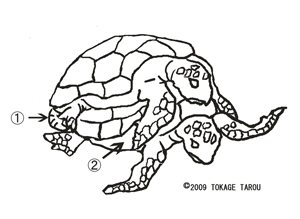
Turtle's mating |
1. Penis is hidden in tail. 2. The nails help the male to stay on the female. The arched plastron of male let him stay on female stably. Mating is successful when the turtles stay in this position for about 2 hours. |
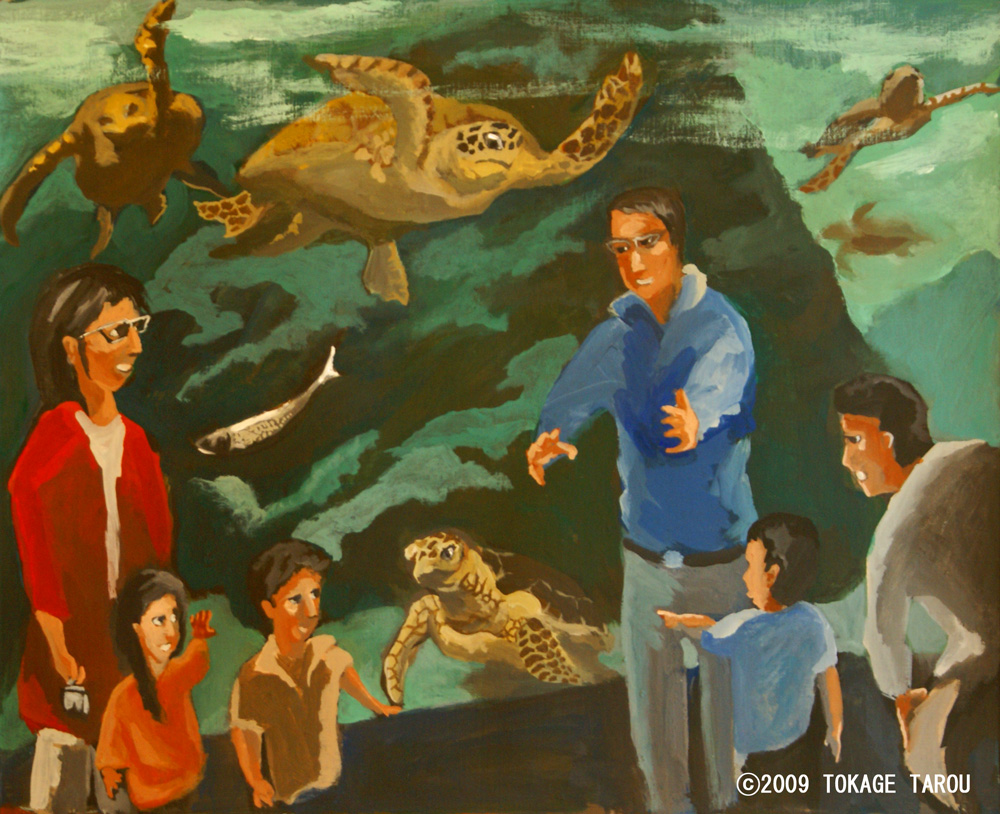
It is said that turtles do not recognize each person, but many turtles came closer when Kasugai approached to the tank.
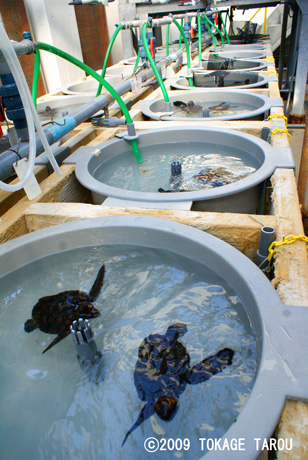
|
Technology helps to watch the eggs glow in the female turtles now. It is possible to guess exactly when the female turtle come up to sand for laying now. But sometimes the turtle return to water without nesting. You are very lucky if you witness them on the beach.
Port of Nagoya Aquarium opens the workshop where the visitors have opportunities to touch baby turtles every summer. "I see a lot of children who are fascinated to feel the powerful legs, and surprised to touch the shell which is still soft", said Yuya Sato, a publicity officer. He said that several events will be scheduled for children to learn about sea turtles.
Turtle Breeding Research Centre next to the aquarium is open for public and free to enter.
Sea Turtle connects Japan and the USA.
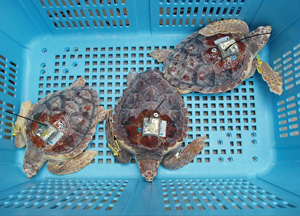
|
|
Turtles with satellite tags Photo provided by NOAA |
It was commonly understood that most of the loggerhead sea turtles in northern pacific were born in Japan. But it was unknown where the baby turtles went and how they grew up. So Port of Nagoya Aquarium, NOAA (National Oceanic and Atmospheric Administration) and HPA (Hawaii Preparatory Academy) affixed satellite tags on juvenile turtles to track them in April 2003.
The tagged turtles were from 1 to 3 years old. Their shells were sized between 20 to 60 cm. 37 of them were born in Port of Nagoya Aquarium and 6 of them had been caught by American fishing boats by accident.
The signals show the locations of the turtles, the depth in the ocean, the swimming speed in the pelagic current, and more.
So far, the research group have found that the juvenile turtles eat mollusk such as clione, jellyfish or fish eggs for 2 to 6 years where Oyashio Current and Kuroshio Current meet. Then they move east to offshore of Baja California where the turtles feed on shrimps and crabs. When they glow up, they start migration across the Pacific Ocean towards Japan.

|
Port of Nagoya Aquarium released 40 turtles in 2005 and 35 turtles in 2006 from the centre of Pacific Ocean around the International Date Line to study their migration east of Hawaii. The turtles were carried to this point by Aichi Maru, which is the training ship of Miya Fisheries High School. Dr. George Balazs from NOAA, Mr. Marc Rice and his students from HPA, the students from Miya Fisheries High School and the Stuffs from Port of Nagoya Aquarium boarded. Chief officer of the turtle breeding and research Tomomi Saito said "it was very important that the turtles born in Nagoya Aquarium helped Japan and the USA to corporate to research the oceanic ecology for natural environment protection and also cultural exchange between the two countries." |

Loggerhead turtle and other turtles eat shrimps, squids, fish (Japanese sand lance) at Port of Nagoya Aquarium. For green turtle, lettuce and cabbage are prepared. |
According to Saito, each of the satellite tag cost 1,000,000 yen (about US$ 11,000.-). It costs more to keep tracking the turtles. "We don't know if we will release more turtles. I think the tagged turtles have already sent us a lot of information and we can learn more about the ecology of loggerhead turtle from it", said he.
Protection of Loggerhead turtleThe population of the loggerhead turtle has been declining. Beach for nesting is disappearing due to bank protection works or development. Ocean water is contaminated by chemical material which may physiologically affect turtles. Many turtles get stuck in the fishing net or fishhook. In Japan, the number of nests and eggs and the beach biology are monitored at 40 seashores by Biodiversity Center of Japan, a project center of Ministry of the Environment. The turtle monitoring is a part of "Monitoring Site 1000", which researches forests, rivers, lakes, wetlands, or seashores and establish data to help the future conservation projects. Many of the monitoring are helped by local universities, study institutions, NPOs and volunteers. " 'Monitoring Site 1000' started in 2003. This project will be carried on at least for 100 years. The research on sea turtle's nesting has just started as a part of 'Monitoring Site 1000'. It takes more years to find the trend of the environmental change. Just to say about this year, the number of nesting turtles is increased to 3 times from last year. It is too early to say that the environment around turtles becomes better", said Shoko Yoshida at Biodiversity Center of Japan. She thinks that the cooperation of many people in different organizations, institutions and groups is essential to protect natural environment for turtles. |

Saito talks about the turtles at the Breeding Research Centre. After a week later the baby turtles hatch, they start to feed.
 By the way, why did NOAA, HPA and Port of Nagoya Aquarium started working together?
By the way, why did NOAA, HPA and Port of Nagoya Aquarium started working together?
I heard about it from Dr. George Balazs of NOAA. The story is continued to NOAA.
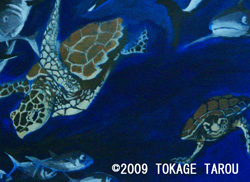 Let's Go!!
Let's Go!!
Pig and Bok choy
While she is swimming....
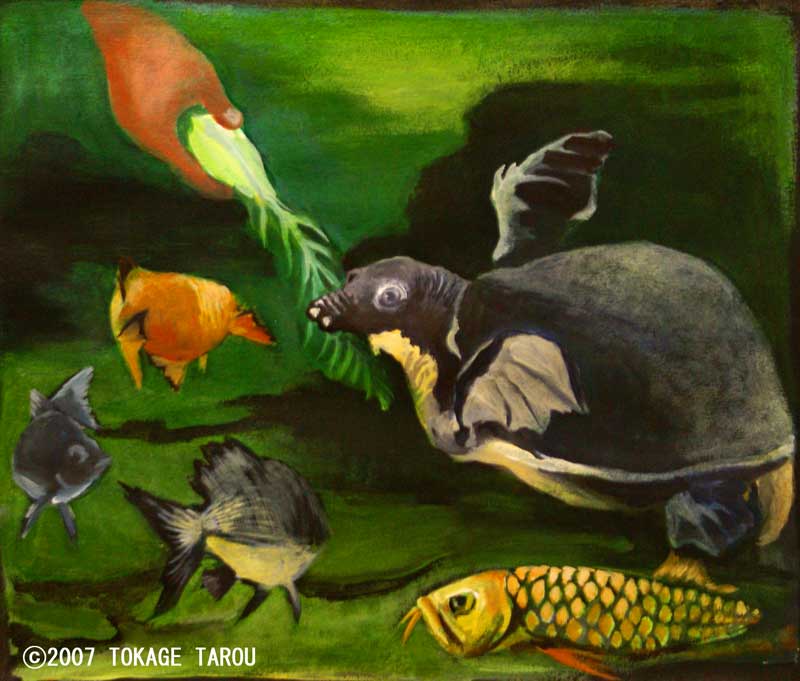
|
Her name is Pig-nosed Turtle. Though her swimming is slow, she can move through the water with grace. Other fish often reach food before she does, but don't worry. Her zookeeper keeps some especially for her. This turtle has a nose like a pig. Pig-nosed turtle, isn't that a good name? |
This is just a small tank, but….
For the anemone fish, it's their whole galaxy.
|
He looks like Disney's famous "Nemo", but the Anemone Fish is not a Clownfish. Gazing into the tank, you feel as if you are living in a galaxy. |

|
A Brief Glimpse of the Dolphins
Take a careful look!

|
Their swimming is so fast. Now they are right in front of you, and then, they are gone in a second. Their bodies are beautifully streamlined. If you are able to take a succesful picture, take a real close look at it. Just before they leave, they take a look at you. They are communicating with you. |
The Long Tooth Grouper, hight graded fish
I love to watch him - he is soooo graceful.

Am I only one in the aquarium who feels like saying "...looks yummy!"? The delicate movements of his fins are mesmerizing. |

|
It's a Sea Turtle's paradise
Private Home with a Private Beach
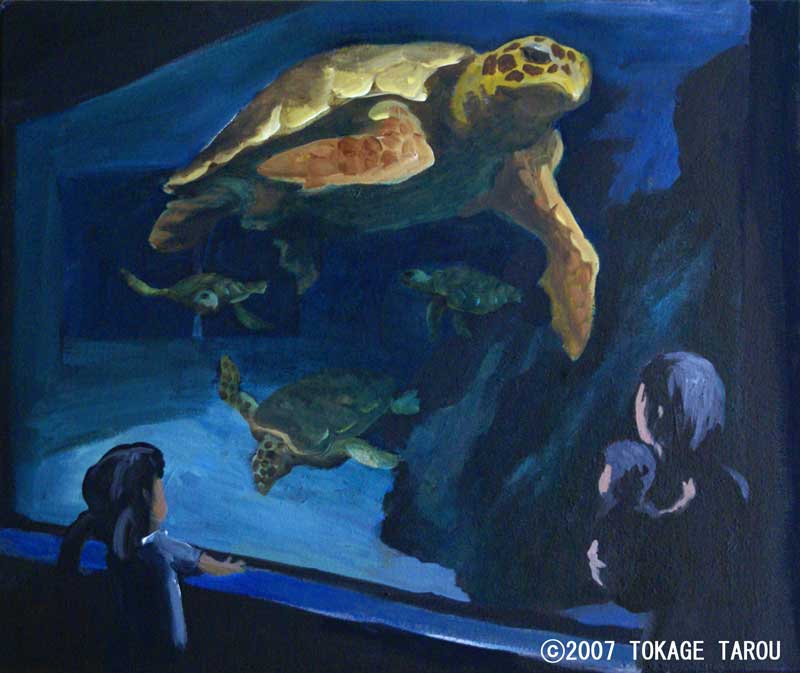
|
The huge tank and the quiet beach are equipped for the Sea Turtles as if they are living in the great outdoors. If you are lucky, you may see them laying their eggs. There are so many predators in the real world that it is not easy to grow as big as they have grown. |